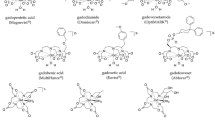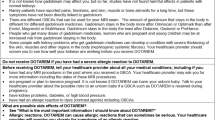Abstract
Background
Numerous recent articles have reported brain gadolinium deposition when using linear but not macrocyclic gadolinium-based contrast agents (GBCAs).
Objective
To determine the current landscape of gadolinium use among pediatric institutions and the knowledge base of radiologists and referring providers with regard to GBCAs and brain gadolinium deposition.
Materials and methods
We e-mailed voluntary closed surveys to 5,390 physicians in various pediatric professional societies between January 2016 and March 2016. We used chi-square and Fisher exact tests to compare response distributions among specialties.
Results
We found that 80% of surveyed pediatric hospitals use macrocyclic contrast agents. In the last year, 58% switched their agent, most commonly to gadoterate meglumine, with the most common reason being brain gadolinium deposition. Furthermore, surveys indicated that 23% of hospitals are considering switching, and, of these, 83% would switch to gadoterate meglumine; the most common reasons were brain gadolinium deposition and safety. Radiologists were more aware of brain gadolinium deposition than non-radiologist physicians (87% vs. 26%; P<0.0001). Radiologists and referring providers expressed similar levels of concern (95% and 89%). Twelve percent of radiologists and 2% of referring providers reported patients asking about brain gadolinium deposition. Radiologists were significantly more comfortable addressing patient inquiries than referring pediatric physicians (48% vs. 6%; P<0.0001). The number of MRIs requested by referring pediatric physicians correlated with their knowledge of brain gadolinium deposition, contrast agent used by their hospital, and comfort discussing brain gadolinium deposition with patients (P<0.0001).
Conclusion
Since the discovery of brain gadolinium deposition, many pediatric hospitals have switched to or plan to switch to a more stable macrocyclic MR contrast agent, most commonly gadoterate meglumine. Despite this, there is need for substantial further education of radiologists and referring pediatric providers regarding GBCAs and brain gadolinium deposition.



Similar content being viewed by others
References
Zhou Z, Lu ZR (2013) Gadolinium-based contrast agents for magnetic resonance cancer imaging. Wiley Interdiscip Rev Nanomed Nanobiotechnol 5:1–18
Dillman JR, Ellis JH, Cohan RH et al (2007) Frequency and severity of acute allergic-like reactions to gadolinium-containing i.v. contrast media in children and adults. AJR Am J Roentgenol 189:1533–1538
Bleicher AG, Kanal E (2008) Assessment of adverse reaction rates to a newly approved MRI contrast agent: review of 23,553 administrations of gadobenate dimeglumine. AJR Am J Roentgenol 191:W307–W311
Grobner T (2006) Gadolinium: a specific trigger for the development of nephrogenic fibrosing dermopathy and nephrogenic systemic fibrosis? Nephrol Dial Transplant 21:1104–1108
U.S. Food & Drug Administration (2007) Public health advisory: gadolinium-containing contrast agents for magnetic resonance imaging (MRI) — Omniscan, OptiMARK, Magnevist, ProHance, and MultiHance. http://www.fda.gov/Drugs/DrugSafety/PostmarketDrugSafetyInformationforPatientsandProviders/ucm053112.htm. Accessed 28 February 2016
Wang Y, Alkasab TK, Narin O et al (2011) Incidence of nephrogenic systemic fibrosis after adoption of restrictive gadolinium-based contrast agent guidelines. Radiology 260:105–112
Altun E, Martin DR, Wertman R et al (2009) Nephrogenic systemic fibrosis: change in incidence following a switch in gadolinium agents and adoption of a gadolinium policy — report from two U.S. universities. Radiology 253:689–696
Frenzel T, Lengsfeld P, Schirmer H et al (2008) Stability of gadolinium-based magnetic resonance imaging contrast agents in human serum at 37 degrees C. Investig Radiol 43:817–828
Sherry AD, Caravan P, Lenkinski RE (2009) Primer on gadolinium chemistry. J Magn Reson Imaging 30:1240–1248
Trout AT, Dillman JR, Ellis JH et al (2011) Patterns of intravenous contrast material use and corticosteroid premedication in children — a survey of Society of Chairs of Radiology in Children's Hospitals (SCORCH) member institutions. Pediatr Radiol 41:1272–1283
Kanda T, Ishii K, Kawaguchi H et al (2014) High signal intensity in the dentate nucleus and globus pallidus on unenhanced T1-weighted MR images: relationship with increasing cumulative dose of a gadolinium-based contrast material. Radiology 270:834–841
Adin ME, Kleinberg L, Vaidya D et al (2015) Hyperintense dentate nuclei on T1-weighted MRI: relation to repeat gadolinium administration. AJNR Am J Neuroradiol 36:1859–1865
McDonald RJ, McDonald JS, Kallmes DF et al (2015) Intracranial gadolinium deposition after contrast-enhanced MR imaging. Radiology 275:772–782
Robert P, Lehericy S, Grand S et al (2015) T1-weighted hypersignal in the deep cerebellar nuclei after repeated administrations of gadolinium-based contrast agents in healthy rats: difference between linear and macrocyclic agents. Investig Radiol 50:473–480
Ramalho J, Castillo M, Alobaidy M et al (2015) High signal intensity in globus pallidus and dentate nucleus on unenhanced T1-weighted MR images: evaluation of two linear gadolinium-based contrast agents. Radiology 276:836–844
Robert P, Violas X, Grand S et al (2016) Linear gadolinium-based contrast agents are associated with brain gadolinium retention in healthy rats. Investig Radiol 51:73–82
Jost G, Lenhard DC, Sieber MA (2016) Signal increase on unenhanced T1-weighted images in the rat brain after repeated, extended doses of gadolinium-based contrast agents: comparison of linear and macrocyclic agents. Investig Radiol 51:83–89
Kanda T, Osawa M, Oba H et al (2015) High signal intensity in dentate nucleus on unenhanced T1-weighted MR images: association with linear versus macrocyclic gadolinium chelate administration. Radiology 275:803–809
Radbruch A, Weberling LD, Kieslich PJ et al (2015) Gadolinium retention in the dentate nucleus and globus pallidus is dependent on the class of contrast agent. Radiology 275:783–791
Cao Y, Huang DQ, Shih G et al (2016) Signal change in the dentate nucleus on T1-weighted MR images after multiple administrations of gadopentetate dimeglumine versus gadobutrol. AJR Am J Roentgenol 206:414–419
Weberling LD, Kieslich PJ, Kickingereder P et al (2015) Increased signal intensity in the dentate nucleus on unenhanced T1-weighted images after gadobenate dimeglumine administration. Investig Radiol 50:743–748
Radbruch A, Weberling LD, Kieslich PJ et al (2015) High-signal intensity in the dentate nucleus and globus pallidus on unenhanced T1-weighted images: evaluation of the macrocyclic gadolinium-based contrast agent gadobutrol. Investig Radiol 50:805–810
Hu HH, Pokorney A, Towbin RB et al (2016) Increased signal intensities in the dentate nucleus and globus pallidus on unenhanced T1-weighted images: evidence in children undergoing multiple gadolinium MRI exams. Pediatr Radiol 46:1590–1598
U.S. Food & Drug Administration (2015) FDA drug safety communication: FDA evaluating the risk of brain deposits with repeated use of gadolinium-based contrast agents for magnetic resonance imaging (MRI). http://www.fda.gov/Drugs/DrugSafety/ucm455386.htm. Accessed 29 April 2016
American Association for Public Opinion Research (2006) Response rates — an overview http://www.aapor.org/Education-Resources/For-Researchers/Poll-Survey-FAQ/Response-Rates-An-Overview.aspx. Accessed 29 February 2016
Eysenback G (2004) Improving the quality of web surveys: the checklist for reporting results of internet surveys (CHERRIES). J Med Internet Res 6:e34
Acknowledgments
The authors received funding from the Ann & Robert H. Lurie Children’s Hospital of Chicago, Department of Pediatrics. We thank the following individuals at Northwestern University, Ann & Robert H. Lurie Children’s Hospital of Chicago for help with the distribution of surveys to pediatric neurologists, pediatric neuro-oncologists, and pediatric radiologists: Dr. Leon Epstein, Dr. Rishi Lulla, Dr. Jason Fangusaro, and Dr. James Donaldson.
Author information
Authors and Affiliations
Corresponding author
Ethics declarations
Conflicts of interest
None
Electronic supplementary material
Below is the link to the electronic supplementary material.
ESM 1
(PDF 16 kb)
Rights and permissions
About this article
Cite this article
Mithal, L.B., Patel, P.S., Mithal, D. et al. Use of gadolinium-based magnetic resonance imaging contrast agents and awareness of brain gadolinium deposition among pediatric providers in North America. Pediatr Radiol 47, 657–664 (2017). https://doi.org/10.1007/s00247-017-3810-4
Received:
Revised:
Accepted:
Published:
Issue Date:
DOI: https://doi.org/10.1007/s00247-017-3810-4




